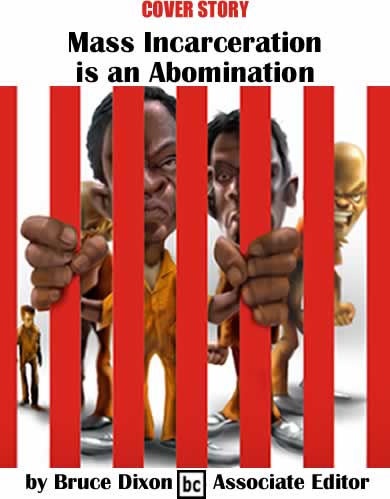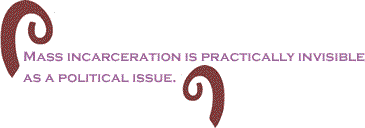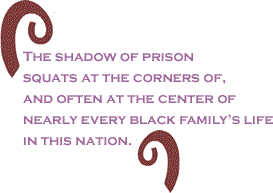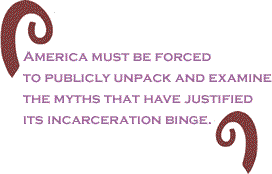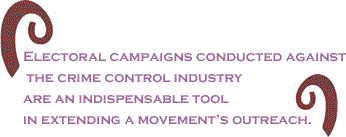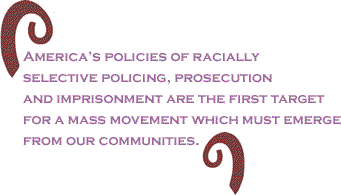
|
|||||||||||||||||||||
|
“A great force of suffering accumulated between the basement of heaven and the roof of hell...” Zora Neale Hurston wrote those words almost seventy years ago at the beginning of her great allegorical work on black America, Moses, Man of the Mountain. She could have been speaking about African America today. As black activists ponder how best to build a mass movement to transform America, a mass movement that must start in but not be confined to our communities, one single low-hanging fruit of organizing opportunity is hard to miss. That opportunity lies in the manifest unfairness and hypocrisy of America’s system of racially selective policing, prosecution and mass imprisonment. These awful public policies are inviting targets for electoral and other mobilizations in black communities and beyond. The fact that America does implement a public policy of racially selective mass imprisonment is well documented and beyond dispute. With under 5 percent of the world’s people, the US accounts for 25 percent of the planet’s prisoners. More than half its 2.2 million prisoners come from the one eighth of its population which is black. Today, an astounding 3 percent of all African Americans languish in prisons and jails, and nearly as many more are on probation, parole, bail, house arrest or court supervision. Tens of thousands of jobless, skill-less, often anti-socialized inmates are released into black communities each month in which jobs, medical care, educational opportunities and family or official support are almost completely absent. Unsurprisingly, many are back behind the walls in a matter of months. Right now, the shadow of prison squats at the corners of, and often at the center of nearly every black family’s life in this nation. Since 1970, the US prison population has multiplied more than six times. The explosive growth of America's incarceration and crime control industries have occurred despite essentially level crime rates over the last four decades. This has only been possible because the public policies which enable and support locking up more people longer and for less have until now been exempt from analyses of their human, economic and social costs or any reckoning of the relationships of spiraling imprisonment to actual crime rates or public safety. Most tellingly, while public discussions of these policies are deracialized, their racially disparate impacts are a seldom discussed but widely known fact. Thus even though the damning numbers are widely reported and well known, mass incarceration is practically invisible as a political issue, even in those heavily black communities which suffer most from its implementation. Making mass incarceration a political issue In the absence of an independent, adversarial press, which might be willing to raise issues on its own and educate the public, US political discourse is limited to what officeholders and candidates say and what the media chooses to report about what they say. As long as no candidate or official can be heard calling for a moratorium on the prosecution of juveniles as adults, it is a non-issue. If no candidate or official is cited in the media advocating the extension of health care, job and educational opportunities or the rights of citizenship to the prisoner class such proposals are absolutely off the table. And unless some candidates or officials somehow get ink or air time publicly questioning the economic and social effects of mass incarceration on children, on families, on whole communities, these concerns remain politically invisible.
The fact that sizeable chunks of the population, including likely majorities in constituencies with large numbers of African Americans might support radical reforms of America’s racially skewed policing, prosecutorial and sentencing practices, if anybody would ask them, is irrelevant. The establishment political consensus and media lockdown assure that no section of the public will ever be asked such questions, and hence will never know how widely shared their own views on the clear injustice of these policies are. If we are to build a mass movement in opposition to America’s crime control and prison industries, we must succeed in putting the facts of racially selective mass incarceration, impoverishment and criminalization, first, in front of our African American communities, and then before the whole of America, and do so effectively, persuasively, consistently and persistently. America must be forced to publicly unpack and examine the myths that have justified its incarceration binge. An indispensable tactic in this struggle must be the mounting of competent, effective campaigns for elected office which directly question the unfairness, along with the social and human costs of these policies, political campaigns which propose radical and understandable measures to shrink the “crime control” and prison industries rather than expand them, and to ameliorate some of the harm already done to families and communities. A short list of such down-to-earth public policy proposals might include, but not be limited to the following:
Over the next several months we should refine and expand the list of policy positions that campaigns must incorporate if they expect the support of a mass movement to end the nation’s policy of racially selective imprisonment. Organic connections between electoral campaigns and mass movements In BC’s June 30, 2005 issue we described some of the essential characteristics of mass movements, progressive and otherwise:
There are already many serious people in our communities involved in churches and voluntary organizations that try their best to offer services to the families of inmates, that lobby and agitate against drug and incarceration policies, that attempt to offer counseling and re-entry services to those emerging from our state and federal gulag. An electoral campaign and a mass movement is an unparalleled opportunity for grandmothers in church-sponsored re-entry programs to work with unchurched young people who know that they, their siblings and classmates are destined to be fodder for the imprisonment industry if things don’t turn around. If that isn’t a formula that can feed a mass movement, no such thing exists. Electoral campaigns conducted against the crime control industry are an indispensable tool in extending a movement’s outreach. Still, we must not allow ourselves to become confused about the differences between a mass movement to change America's policy of selective policing and racist incarceration, and an electoral campaign, even ones that succeed in putting the issue of mass imprisonment at its center. Unlike a mass movement, a political campaign is a decorous, time-limited legal exercise. We must know that political campaigns have often heralded the demobilization of a mass movement, even when that movement’s objectives have not been met. Being able to use electoral campaigns to advance the agenda of a mass movement demands prior preparation and steadfast resolve, lest the candidate before or after election stray from within the bright lines of opposing the incarceration of juveniles as adults, or demanding racial and ethnic impact statements and evaluation for sentencing legislation, to use two of several possible examples.
The culture of campaigns and officialdom as practiced in America today makes officeholders unaccountable to anyone except corporate cash and corporate media. Hence it is suicidal for the leaders of local movements to wait for candidates to emerge and then decide which if any to support. Candidates that surface without the help of a movement against mass incarceration will have intended all along to run whether such a movement existed or not, and should hence be shunned. Local “movement leaders,” forced to choose among such a crop, will inevitably choose the “least worst” candidate, who will offer only tepid support to a movement’s “bright line” issues and will not advance the cause of de-legitimizing our nation’s racially skewed crime control industry at all. To guarantee that political campaigns endorsed by the movement do indeed advance the cause, over the individual fortunes and pressures to which candidates are prey, we must set up local, statewide and even regional screening committees to recruit and interview suitable candidates for office, and to facilitate the channeling of funds and campaign expertise to those who pledge to stay within the bright lines and place the issue of mass incarceration squarely at the center of their campaigns. A national PAC whose sole purpose is funding movement-vetted candidates running against mass imprisonment – and other “bright line issues – should be one of the outcomes of our next national dialogue, now commonly referred to as “going back to Gary.” The gathering will occur in the first quarter of next year. Candidates who run against the crime control industry and racist mass imprisonment will certainly need all the help they can get. Although they are likely to receive surprising support and attract tons of youthful talent and enthusiasm in our base communities, they will face formidable odds getting their message out through an indifferent or hostile media. Time-tested best practices like accountable voter registration drives, accurate phone and door to door canvasses in base areas, and competent Get-Out-The-Vote (GOTV) practices will have to be combined with newer innovations to circumvent the monopoly that corporate media have on access to the American public, including the black public. BC will explore the impact of some of these new media tactics and tools in an upcoming article. Targeting local prosecutors and sheriffs
Federal prosecutors are presidential appointees. But the state level gatekeepers for the prison industry’s stream of human raw material are local prosecutors – elected officials who must run for office at the level of counties, cities and judicial circuits. A number of these jurisdictions have black majorities. The local politicians with responsibility for housing pre-trial inmates are usually elected county officials too: sheriffs. The table below, which arranges the list of US counties to show those with the top 130 black populations, shows a target-rich environment, with fully 37 jurisdictions having African American population percentages of 30% or greater. Every major city in the state of Georgia, for instance, is on the list, including 3 of the 4 largest counties in metro Atlanta. And you don’t need a black majority to run against mass imprisonment and win. A black prosecutor ran against the Rockefeller drug laws in Albany NY, where African Americans are a distinct minority – and won. Click here to view Counties by Black Population chart Unpacking the myths around the crime control industry Crime control policies on every level in the U.S. are based upon racist myths. Myths are powerful because they are never questioned, never examined, never unpacked. Nobody disputes that Justice Department data going back decades shows rates of drug use among blacks and whites to be about the same. A combination of white racism and a willingness to ignore unpleasant facts largely account for white indifference at the disparity between white and black rates of arrest and prosecution for offenses created with equal frequency by both groups. But black support for an industry and for public policies that criminalize a third of all young black men, which disrupt and retard the formation of strong families, and cripple workforce and educational opportunities for such a broad cross section of us, is at best ambivalent and at worst paper-thin, even among African Americans working in the industry, based as it is upon a tenuous mass acceptance that this is all somehow part of the normal balance of society. “It’s hot in the summer,” we tell ourselves, “it’s cold in the winter, and a third of all young black men are in and out of jail.” Or we say “It’s a trap! It was out there waitin’ for them and they fell in it!” Both these positions are understandable as mental adjustments much like those that some of our forbears thought they had to make to get along in the world of triumphant Jim Crow and white terror eighty or a hundred years ago. Such views are uncomfortable for the black people that hold them, and unstable. We must engage them by depicting mass incarceration not as the way normal societies behave, but as a failed experiment that punishes our entire community, a malevolent social policy that can be challenged and must be changed.
Our language must be carefully constructed to aid in the process of demythologizing crime and crime control policies. We need new terminology, new language that better enables people to grasp the issues around mass imprisonment and the criminal justice industry as malevolent social policies which can be changed, rather than unalterable facts like cold in the winter and heat in the summer. For example, the terms “criminal justice system” and “corrections” ought to be replaced in all our dialogue with terms like “crime control industry”, or “imprisonment industry.” A “system” is a very generalized term that does not tell us much, while an “industry” is a very specific kind of system. To call it an “industry” instead raises powerful questions of profit and accountability which are obscured when we call it anything else. White establishment pundits and politicians of a generation ago warned us. They predicted the coming of what they called a “white backlash.” This was their name for a predicted white racist response to the just demands of African America for equality of opportunity and economic justice advanced by the movement of the 1960s, a response some feared would entrench racial inequality and privilege deeper than ever before. They were right. Beginning in the 1970s the selective mass imprisonment of African Americans helped to swell the six or sevenfold expansion of the prison population. And while the rhetoric and official policies that enabled this were ostensibly race-neutral, the results were an open secret. Around the same time, Dr. King was saying that the movement which would save the nation’s soul would have to emerge from black America. He was right too. The struggle to de-legitimize the racist crime control and prison industries are at the heart of this generation's struggle to de-legitimize racism itself. America’s policies of racially selective policing, prosecution and imprisonment are the first target for a mass movement which must emerge from our communities, but which must not be confined to them. Laying the intelligent groundwork for such a movement remains the task before us, when we go back to Gary.
|
Your comments are always welcome. Visit the Contact Us page to send e-Mail or Feedback or Click here to send e-Mail to [email protected] e-Mail re-print notice
If you send us an e-Mail message we may publish all or part of it, unless you tell us it is not for publication. You may also request that we withhold your name. Thank you very much for your readership. |
| July 21 2005 Issue 147 |
|||||||||
|
|||||||||
|
|
|||||||||
| Printer Friendly Version | |||||||||
 |
|||||||||
 |
|||||||||
| |
|||||||||
| |
|||||||||





















